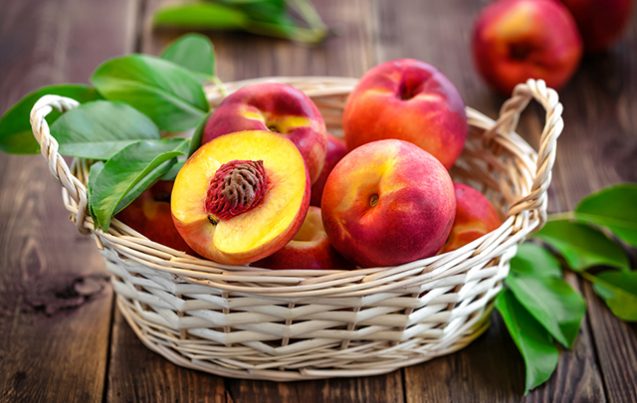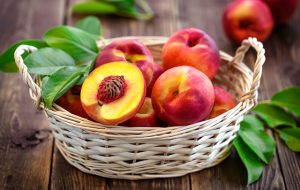
Nectarine – sources, health benefits, nutrients, uses and constituents at NaturalPedia.com
Wednesday, June 21, 2017 by Earl Garcia
http://www.naturalpedia.com/nectarine-sources-health-benefits-nutrients-uses-and-constituents-at-naturalpedia-com.html

Nectarines are fragrant and juicy fruits that are classified as drupes, which include peaches, plums, almonds and damson. The fruit is believed to be native to China, and quickly spread across Central Asia and Persia to Europe through the ancient silk road. Nectarines are slightly larger than plums, and reach a size akin to mature peaches. Nectarines are characterized by their smooth firm skin and orange to orange-red hues when ripe.
List of known nutrients
Nectarines are an excellent source of essential vitamins and minerals that stave off a plethora of diseases. Nutrients found in nectarines are as follows:
- Beta-Carotene
- Calcium
- Carbohydrates
- Copper
- Dietary fiber
- Folates
- Iron
- Lutein
- Magnesium
- Manganese
- Niacin
- Pantothenic acid
- Phosphorus
- Potassium
- Protein
- Pyridoxine
- Riboflavin
- Thiamin
- Vitamin A
- Vitamin C
- Vitamin E
- Vitamin K
- Zeaxanthin
- Zinc
Medicinal uses for nectarine
Nectarines are known to contain high levels of antioxidants that combat cancer. The fruit’s chlorogenic acid is touted to contain chemopreventive properties that prevent the proliferation of colon carcinogenesis, thereby reducing the risk of colon cancer and various tumors. On the other hand, the high beta-carotene content in nectarines have been found to protect the body against lung cancer onset. Likewise, nectarines are known to prevent oral and cavity cancer.
The fruit’s rich chlorogenic acid and anthocyanin content inhibit the oxidation of bad cholesterol. This in turn prevents arterial hardening and promotes proper platelet circulation. Aside from this, the high flavonoid content in nectarines reduces the risk of platelet aggregation and lowers the odds of developing atherosclerosis.
The stone fruit is an excellent source of potassium, which prevents the onset of hypokalemia. This is a condition characterized by potassium deficiency that often leads to poor muscular health and cardiac arrhythmia. Nectarine’s high potassium content helps promote protein synthesis, supports muscle function, and maintains electrolyte balance. Nectarines are also known to boost cellular health. Additionally, the stone fruit contains high levels of phosphorus that promotes healthy bones and teeth. On the other hand, the fruit’s rich iron content encourages hemoglobin formation in red blood cells.
In addition, nectarines contain significantly high levels of lutein, an essential nutrient that promotes eye health and slashes the risk of macular degeneration. Likewise, the fruit is notably high in dietary fiber that facilitate digestion and bowel movement. This prevents the onset of certain digestive system conditions such as gastritis, ulcers and constipation.
Furthermore, nectarines are an excellent source of bioflavonoids, antioxidants, and important nutrients that promote skin health. The fruit is also high in folate, which makes it an ideal food fare for pregnant women. Likewise, the fruit’s high nutrient content boosts the immune system, reducing the risk of simple diseases such as common coughs and colds as well as more serious conditions like malaria.
Body systems supported by nectarine
Nectarines are essential in maintaining a healthy digestive, immune, and circulatory systems. The fruit benefits the eyes, skin, bones, and the muscles too.
Ways to use nectarine
Like peaches and plums, nectarine’s sweet flavor has made the fruit a popular staple in backed goods such as pies and cakes. The fruit is also in demand in making frozen desserts such as popsicles and ice cream. Delish.com has compiled many interesting nectarine recipes on its website.
Where to learn more
- 10 Foods You Should Always Buy Organic
- Take a bite out of the summer heat with these refreshing and healthy recipes
- Food Forests – Design modern solutions from ancient traditions
- Peaches, nectarines and berries lower breast cancer risk by 41 percent
- Flatulence-free belly: Six foods for a happy belly
Summary
Nectarines prevent cancers, heart disease, and hypokalemia.
The fruit also prevent eye diseases and promote muscle and bone health.
The fruit benefits the digestive, immune, and circulatory systems.
Nectarines support the eyes, skin, bones, and muscles.
Sources include:
Tagged Under: Tags: Nectarine






